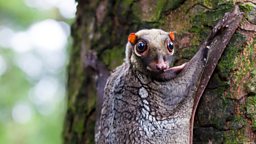Main content
Colugo
Gliding could also protect colugos from dangerous predators, and reduce the risks of accidents and injuries when climbing on spindly branches, so it could also give a long-term benefit as well as saving it time.
Why do colugos glide from tree to tree?
- Scientists studied gliding in colugos by attaching accelerometer packs to the backs of six individuals (2011)
- They analysed the data and realised that colugos only climb a relatively small height to achieve their lengthy glides, on average 8 metres for a 30-50 metre glide.
- The hypothesis was that colugos would use far more energy clambering through the canopy to get to other trees than they would use in a glide covering the same distance.
- They were surprised to find that colugos in fact use 1.5 times more energy gliding than clambering.
What was clear though is that although gliding doesn't save energy, it does save time. Gliding allows them to travel ten times as fast, and cover long distances, which means they can spend more time foraging.






